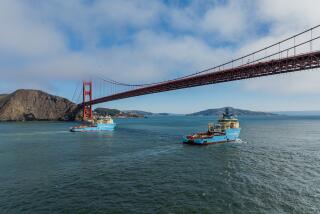Russia Oil Cleanup Reported Largely Over : Environment: Damage caused by pipeline leaks in Arctic is 72% repaired. U.S. firm doing work may form venture with company responsible for incident<i> .</i>
- Share via
MOSCOW — After a long summer of greasy labor, most of Russia’s worst oil spill has been cleaned up, and the rest has been contained so it will not wash into Arctic rivers in the spring, officials said Wednesday.
“Basically, we are satisfied,” said Vadim P. Voronin of the World Bank, which is funding the cleanup project in Usinsk, about 1,000 miles northeast of Moscow. As of this week, Voronin said, “about 72% of the work has been done.”
“Obviously, there will be some pollution left. But the gross oil will be removed,” he said. “The rest of the work must be done by nature itself.”
In an unexpected spinoff, the Russian oil company responsible for the Usinsk accident is now considering forming a joint venture with the American firm hired to mop up the mess to create Russia’s first oil-spill cleanup company, spokespersons for both firms said.
The developments are the first upbeat environmental news to come out of the befouled Russian Arctic since the summer of 1994, when a dilapidated oil pipeline ruptured in about a dozen places, gushing millions of gallons of hot crude oil into creeks and streams that feed the mighty Pechora river.
Experts are still arguing about how much oil really spilled, but the World Bank estimate is 100,000 tons--roughly three times the size of the Exxon Valdez disaster in Alaska in 1989.
By any measure, the Usinsk spill was one of the world’s largest, and it added to the woes of a region already ravaged by two decades of slipshod Soviet oil exploration.
Miles of stream bed were covered with a yard-thick layer of congealed slime, and oil slicks made their way downstream to further damage the once-rich fishing grounds that stretch 450 miles down the Pechora to the Arctic Ocean.
Environmentalists say the delicate ecosystem will require decades, if not centuries, to recover.
The World Bank and the European Bank for Reconstruction and Development have lent a total of $124 million to deal with the damage: about $45 million to clean up the spill, $4.5 million to help the local farmers and fishermen whose livelihoods have been ruined by oil contamination, and the rest to build 60 miles of oil pipeline and modernize the decaying infrastructure in the oil fields.
AES/Hartec, a U.S.-Australian joint venture hired to organize the cleanup, arrived in Russia on March 9. After some initial delays, it now has 884 people working on the project, 93% of whom are Russian. Crews have been working around the clock at some of the most contaminated sites.
This spring, teams built giant dams and ponds to contain the oily water. Now they are flooding stretches of tundra and hosing down blackened stream beds, then skimming the oil that collects downstream.
Hartec is responsible for cleaning up 173 acres, including about 18 miles of stream beds. Work has been completed at two of the six cleanup sites, areas that looked like oil swamps six months ago, said Hartec spokesman Sam Sacco.
“It’s clean, it’s green,” said Sacco, a native of Oakland. “There are some small traces of dark spots in some areas, but that’s only because to wash them out would have been more damaging to the environment, and the grass can grow through.”
Though the foliage died long ago, the root systems are still intact, and if the soil is cleaned gently, plant life will re-emerge, Sacco explained.
“I don’t want to overstate it, but it looks good,” he said.
The recovered oil and water is being sent back to pipeline owner Komineft for reprocessing.
Work will not be completed at two of the largest sites before the northern winter sets in, probably in early October. However, Sacco said the remaining gunk is trapped behind massive dams and will not be able to wash down into the Kolva river, which feeds the Pechora.
One of the goals of the project was to leave Russia with the know-how and equipment to deal with future oil spills. All of the equipment imported for the cleanup--skimmers, pumps, steam cleaners, booms, boats and even helicopters--will be left to Komineft, the Usinsk-based oil company.
More to Read
Sign up for Essential California
The most important California stories and recommendations in your inbox every morning.
You may occasionally receive promotional content from the Los Angeles Times.













